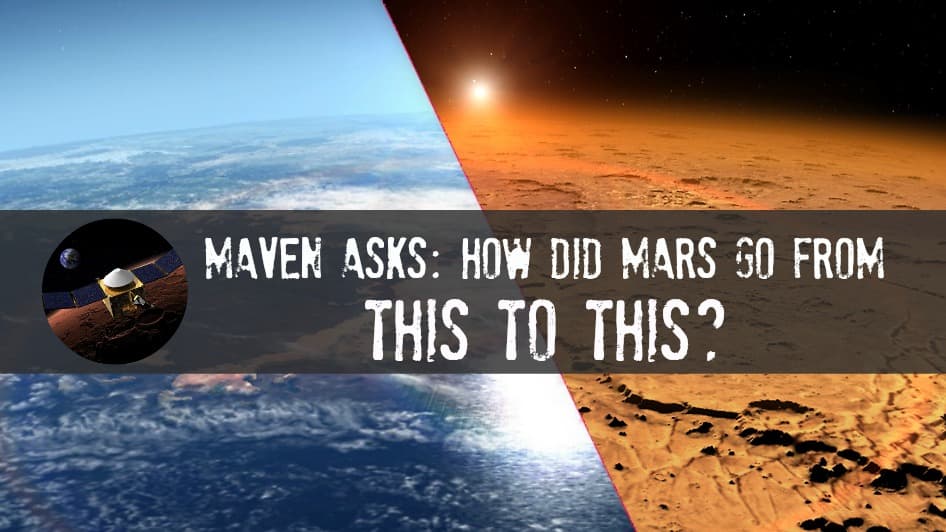NASA's 'Mars Atmosphere and Volatile EvolutioN' (MAVEN) spacecraft — the first satellite designed to study the upper atmosphere of Mars — arrived on the Red Planet less than a month ago, and despite the fact that it is still in the process of calibrating, it is already returning data on an unprecedented scale.
Bruce Jakosky, MAVEN's principal investigator, stated "All the instruments are showing data quality that is better than anticipated at the early stage of the mission. All instruments have now been turned on — although not yet fully checked out — and are functioning nominally. It’s turning out to be an easy and straightforward spacecraft to fly, at least so far. It really looks as it we’re headed for an exciting science mission."
It's believed that in its infancy, Mars resembled present day Earth. However, much has changed in the intervening years, namely its atmosphere. Currently, the Martian atmosphere is just one-third of Earth's (and it's thickness is just 1 percent). Over the past few million years, Mars has been gradually losing its atmosphere at a quicker rate than ever before, and no one knows why. But with the help of MAVEN, scientists hope to learn the cause of this dramatic atmospheric loss. MAVEN will hopefully accomplish this by studying the amount of atmospheric carbon, hydrogen, and oxygen. Analyzing how the abundances of these elements change over time will provide key insights into how a planet transitions from being lush and wet to barren, cold world and inhospitable.
Mars' atmosphere contain carbon dioxide and water molecules. MAVEN is tasked with studying how these compounds are broken up into their component elements, and what percentage of each component is in the atmosphere.
(Click on the boxes to expand)
[su_accordion]
[su_spoiler title="Carbon" style="fancy"]
Carbon, which comes from the breakdown of carbon dioxide (a greenhouse gas), happens to be the most abundant element in the Martian atmosphere. Long ago, it may have once helped make conditions conductive for the retention of liquid water on the surface.
The image we see on the right was captured by MAVEN's Imaging Ultraviolet Spectrograph (IUVS). Here, we can see Mars (red circle) and on the right outer edge there is a bright region, this bright line is indicative of atmospheric carbon. Based on this preliminary data, scientists are hopeful they will be able to measure how much carbon is being lost to space very early on in the mission. [/su_spoiler]
[su_spoiler title="Hydrogen" style="fancy"]
Once hydrogen, which is incredibly light, reaches the upper atmosphere, it escapes into space rapidly. Scientists now think escape processes like this played a large role in Martian climate change.
The hydrogen data is shown to the right here. Again we see Mars represented as a red circle, and the escaping hydrogen is represented by a bright, white band.
Speaking of the preliminary findings, Mike Chaffin — MAVEN remote sensing team member — remarked: "This image of hydrogen is the best picture ever captured of atomic hydrogen in the upper Martian atmosphere. It is an important measurement to make because the hydrogen we are looking at here comes from water lower down in the atmosphere." [/su_spoiler]
[su_spoiler title="Oxygen" style="fancy"]
Oxygen, like carbon, is a heavier element that hangs around closer to the planet's surface. That being said, there are chemical processes taking place between light from the Sun hating up the oxygen. When this happens, the oxygen atoms gain energy and rise up through the atmosphere, eventually escaping into outer space. Oxygen is an important element to study, probably the most important, as it represents the breakdown of both water and carbon dioxide. It is the key to piecing together a complete picture of how Mars lost its atmosphere.
The oxygen data represented here mostly shows colder oxygen atoms. However, you can see the heated oxygen, represented by a hazy band, escaping into space. Justin Deighan, another MAVEN remote sensing team member, described this image as "The first image ever, clearly showing the high-energy oxygen atoms extending away from Mars." [/su_spoiler]
[/su_accordion]
Deighan states, "You can see how MAVEN has given us a simultaneous global picture of all the atomic products of carbon dioxide and water, which allows us to begin to measure the escape rates from the upper atmosphere and do the science that MAVEN came to do."
After all the data is collected, scientists should be able to look back to a time when Mars' atmosphere was more appreciable. Then, we can hopefully determine exactly what stripped Mars of most of its atmosphere. This, in turn, might give us a glimpse at our own planet's future.
Additionally, MAVEN has mapped out the Red Planet's ozone layer. Here on Earth, we attribute the loss of ozone to man-made chemicals; however, on Mars, ozone loss is definitely natural (astronomers suggest that it might be the result of something as simple as sunlight and water vapor).
As the map below shows,ozone is abundant in the polar regions, as they receive less sunlight.
Deighan describes ozone as being important for understanding how Mars lost its water. "It's those same reactions that begin the process of breaking water down into atomic hydrogen and transporting it into the upper atmosphere where it can escape into space," he explains.
Once both data sets are combined, scientists will have a more complete picture of what is going on in the upper and lower atmosphere. In addition to determining how much atmosphere is currently being lost, we'll be able to see exactly how much was lost over time.
Stay tuned for more science!
[su_divider text="Go back to top" size="2"]
Share This Article
